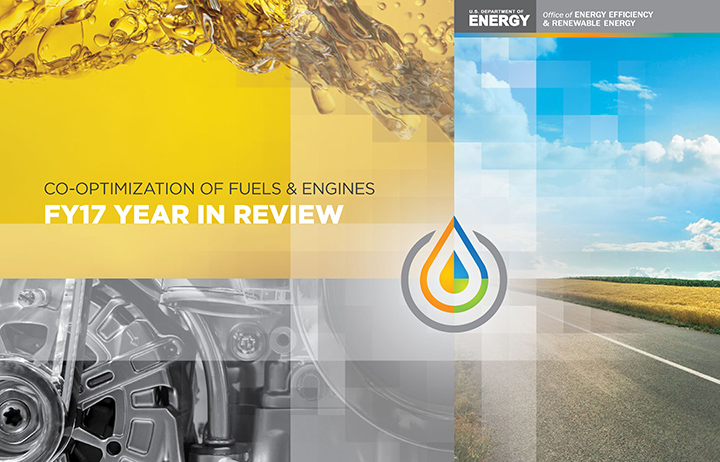Co-Optima Transportation Ingenuity Capitalizes on Strengths of U.S. Energy Resources and Existing Infrastructure

The Co-Optima FY17 Year in Review report spotlights the initiative's advances in engine and fuel innovation.
The United States could increase its domestic fuel supplies by 25 billion gallons per year while leveraging the nation's existing $1 trillion fuel infrastructure according to a Co-Optimization of Fuels & Engines (Co-Optima) report released this week. The FY17 Year in Review describes recent advances including identification of key properties for new fuels, assessment of compatibility with vehicle components and infrastructure, and expansion of research to encompass solutions for the entire on-road fleet. This research effort, led by the National Renewable Energy Laboratory (NREL) for the U.S. Department of Energy (DOE), is providing industry with the scientific underpinnings needed to accelerate introduction of high-performance fuels and engines that reduce energy consumption, improve air quality, and lower drivers' costs.
The Co-Optima initiative is the first to fully integrate the science and engineering needed to create engines and fuels that work more effectively together. It is projected that this integrated approach could lead to an annual $35 billion in fuel cost savings, increase energy independence with the use of domestic feedstocks for biofuels, and create up to 500,000 new jobs. NREL is collaborating with eight other national labs and 13 universities on the landmark project.
"We're examining the full landscape of technologies and factors that can move the needle on the performance and efficiency of today's vehicles, while also casting forward to explore revolutionary innovation that will deliver more dramatic improvements down the road," says Co-Optima Project Leader and NREL Vehicle Technologies Program Manager John Farrell. "Gasoline and diesel engines are going to be around for years to come. Let's make them as smart and clean as we can—while continuing to press forward on new groundbreaking solutions."
Much of the Co-Optima fuels research is focused on components known as blendstocks, which can be produced from a wide spectrum of domestic resources, including natural gas, petroleum―or from renewable, non-food, domestic biomass such as forestry and agricultural waste. They have the potential to create much-needed new jobs in farm country, while leveraging a billion-ton annual feedstock reserve and keeping energy dollars in the United States.
Co-Optima's key accomplishments in the last year include:
- Expanding research to encompass solutions for the entire on-road fleet, from light-duty passenger cars to heavy-duty freight trucks
- Identifying representative blendstocks from five chemical families that provide the key fuel properties needed for high-efficiency SI engines.
- Assessing blendstock compatibility with vehicles and infrastructure
- Completing integrated, systems-level analyses of blendstocks in relation to economic, technological, market, and environmental factors.
Although vehicles have become more fuel efficient, transportation still accounts for 70% of overall U.S. consumption of petroleum, a quarter of which is imported. The Co-Optima team is addressing the need for increased efficiency through two concurrent phases of R&D that explore the improvement of near-term SI engine efficiency, including multi-mode high dilution SI, as well as advanced compression ignition and low-temperature combustion strategies needed for longer-term, higher-impact solutions. Researchers are also assessing new fuels for compatibility with polymers, plastics, and metals used in vehicles, as well as the equipment and infrastructure used to produce, transport, and dispense fuels.
In the coming year, the Co-Optima research team will take a closer look at infrastructure and vehicle material compatibility, in addition to scale-up requirements for blendstock production. Ultimately, this early-stage R&D will provide industry with greater flexibility in delivering the automotive technologies and fuels needed to put the most efficient and high-performance cars and trucks on the road.
Sponsored by DOE's Vehicle Technologies Office (VTO) and Bioenergy Technologies Office (BETO), Co-Optima partners include NREL as well as Argonne, Idaho, Lawrence Berkeley, Lawrence Livermore, Los Alamos, Oak Ridge, Pacific Northwest, and Sandia National Laboratories.
Learn more about NREL's involvement in Co-Optima and other transportation research.

